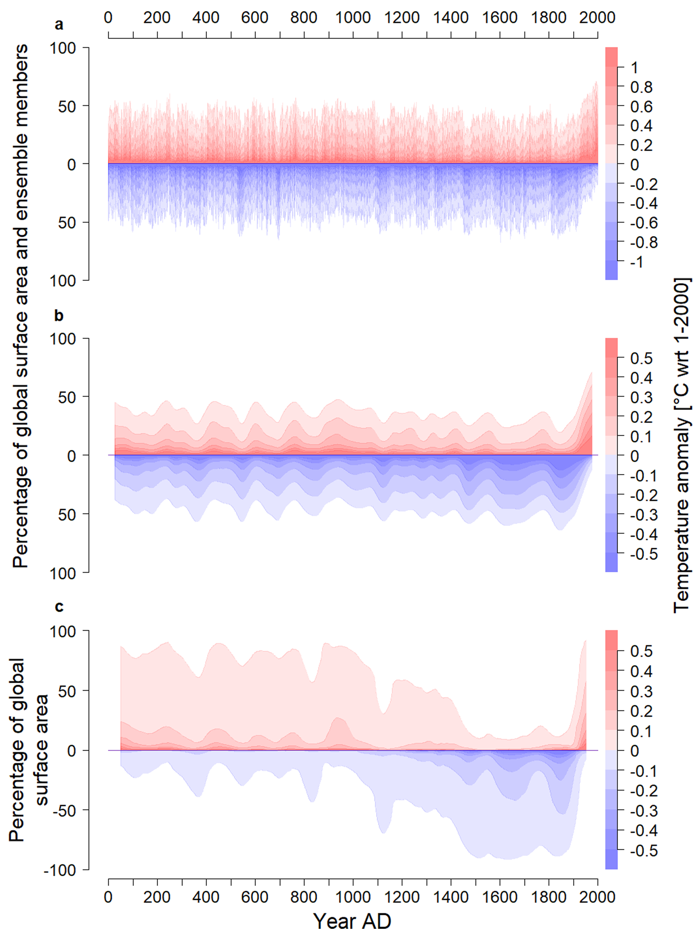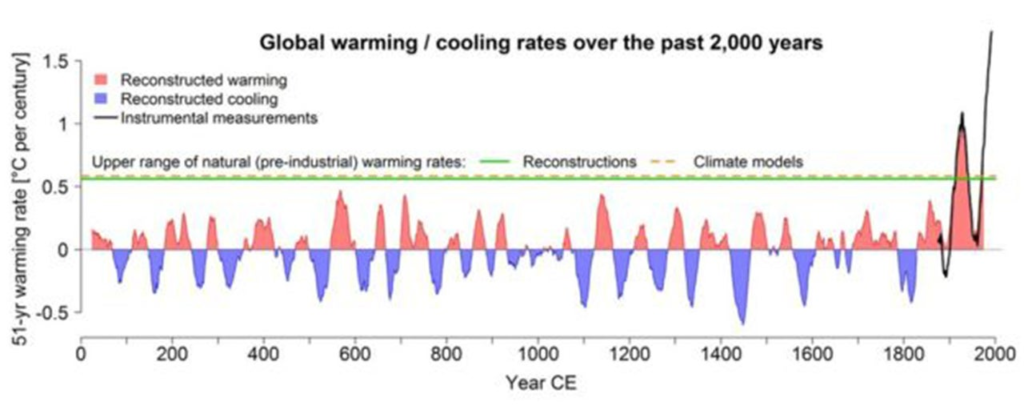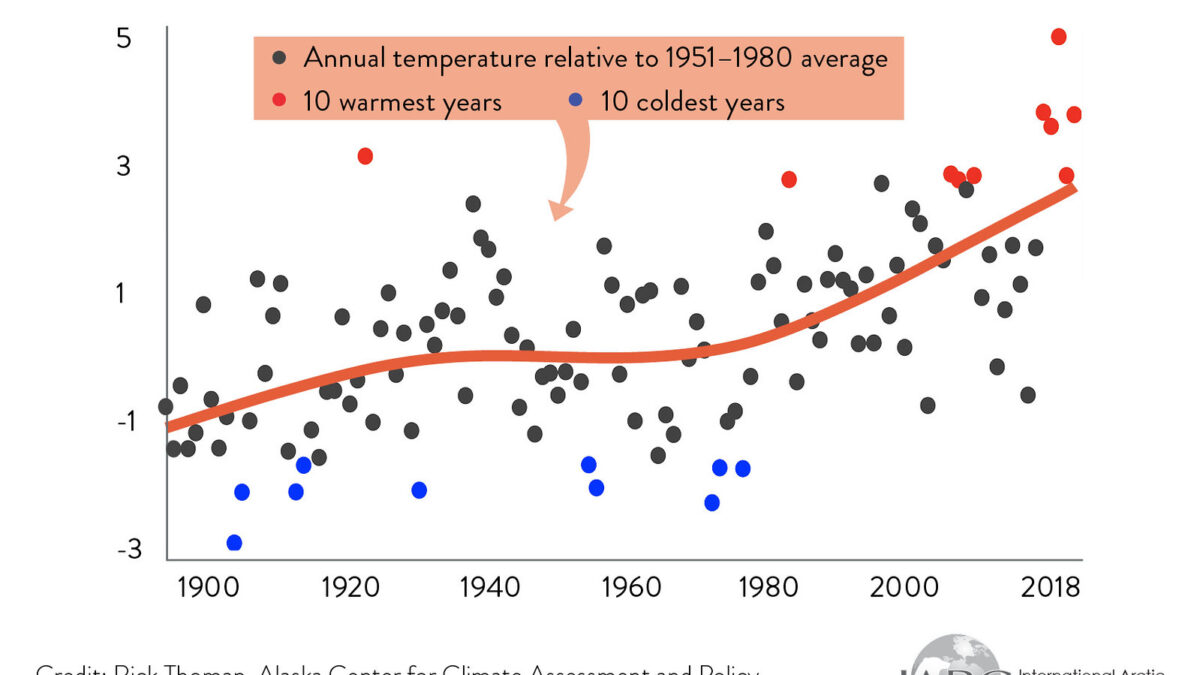The climate is warming faster than it has in the last 2,000 years
24 July 2019 (OCCR) – In contrast to pre-industrial climate fluctuations, current, anthropogenic climate change is occurring across the whole world at the same time. In addition, the speed of global warming is higher than it has been in at least 2,000 years. That’s according to two studies from the University of Bern.
Many people have a clear picture of the “Little Ice Age” (from approx. 1300 to 1850). It’s characterized by paintings showing people skating on Dutch canals and glaciers advancing far into the alpine valleys. That it was extraordinarily cool in Europe for several centuries is proven by a large number of temperature reconstructions using tree rings, for example, not just by historical paintings. As there are also similar reconstructions for North America, it was assumed that the “Little Ice Age” and the similarly famous “Medieval Warm Period” (approx. 700 – 1400) were global phenomena.
As I sit in a sweltering heatwave in London, the big question remains: are people going to force governments and businesses to take swift action to drive down greenhouse gas emissions to zero to stabilise the climate?
Prof. Simon Lewis, Professor of Global Change Science, University College London, commenting on Neukom, et al., 2019 / Nature
But now an international group led by Raphael Neukom of the Oeschger Center for Climate Change Research at the University of Bern is painting a very different picture of these alleged global climate fluctuations. In a study which has just appeared in the well-known scientific journal Nature, and in a supplementary publication in Nature Geoscience, the team shows that there is no evidence that there were uniform warm and cold periods across the globe over the last 2,000 years.
Climate fluctuations in the past varied from region to region
“It’s true that during the Little Ice Age it was generally colder across the whole world,” explains Raphael Neukom, “but not everywhere at the same time. The peak periods of pre-industrial warm and cold periods occurred at different times in different places.” According to the climate scientist from Bern, the now-debunked hypothesis of climate phases occurring at the same time across the globe came about because of an impression that is defined by the climate history of Europe and North America. In the absence of data from other parts of the earth, this notion was applied to the whole planet, raising expectations that relatively cold or warm periods throughout the last 2,000 years were globally synchronous phenomena. But it has now been shown that this was not the case.
The authors of the study in Nature see the explanation for that as being that regional climates in pre-industrial times were primarily influenced by random fluctuations within the climate systems themselves. External factors such as volcanic eruptions or solar activity were not intense enough to cause markedly warm or cold temperatures across the whole world for decades, or even centuries.
The warmest period of the past two millennia occurred during the twentieth century for more than 98 per cent of the globe. This provides strong evidence that anthropogenic global warming is not only unparalleled in terms of absolute temperatures, but also unprecedented in spatial consistency within the context of the past 2,000 years.
Neukom, et al., 2019 / Nature
The researchers relied on a database from the international research consortium PAGES (Past Global Changes, www.pastglobalchanges.org), which provides a comprehensive overview of climate data from the last 2,000 years, for their investigation of five pre-industrial climate epochs. In addition to tree rings, it also includes data from ice cores, lake sediments and corals. To really put the results to the test, the team led by Raphael Neukom analyzed these data sets using six different statistical models – more than ever before. This allowed for the calculation of the probability of extremely warm or cold decades and centuries, and not just the calculation of absolute temperatures. The result was that no globally coherent picture emerged during the periods being investigated.
“The minimum and maximum temperatures were different in different areas,” says Raphael Neukom. So thermal extremes across the world cannot be inferred from regional temperature phenomena like the oft-mentioned “Medieval Warm Period” in Europe and North America.
The current warm period is happening across the world for the first time
The results look very different for recent history. Both studies show that the warmest period of the last 2,000 years was most likely in the 20th century. They also show that this was the case for more than 98 percent of the surface of the earth. This shows – once again – that modern climate change cannot be explained by random fluctuations, but by anthropogenic emissions of CO2 and other greenhouse gases. What we didn’t know until now is that not only average global temperatures in the 20th century are higher than ever before in at least 2,000 years, but also that a warming period is now affecting the whole planet at the same time for the first time. And the speed of global warming has never been as high as it is today.
The climate is warming faster than it has in the last 2,000 years
expert reaction to three studies on temperature trends over the past two millennia
24 July 2019 (SMC) – Studies, published in Nature Geoscience and Nature, report on global temperature trends over the last 2000 years.
Prof Simon Lewis, Professor of Global Change Science, University College London, said:
“Another week and scientists are publishing another set of reports reinforcing the abundant evidence that human actions are driving rapid changes to the climate of our home planet. Earth’s surface temperature is rising fast. With new robust analyses and new and painstakingly collated data, the last few decades are again shown to stand out: it is warming everywhere.
“As I sit in a sweltering heatwave in London, the big question remains: are people going to force governments and businesses to take swift action to drive down greenhouse gas emissions to zero to stabilise the climate?” […]
Prof Mark Maslin, Professor of Climatology, University College London (UCL), said:
“Neukom and colleagues using 700 climate records from around the world covering the last 2,000 years demonstrate that the Little Ice Age and the Mediaeval Warm period were localised climatic events. Over the last 2000 years the only time the global climate has change synchronically has been in the last 150 years when over 98% of the surface of the Planet has warmed.
“This paper should finally stop climate change deniers claiming that the recent observed coherent global warming is part of a natural climate cycle. This paper shows the truly stark difference between regional and localised changes in climate of the past and the truly global effect of anthropogenic greenhouse emissions.” [more]
expert reaction to three studies on temperature trends over the past two millennia

No evidence for globally coherent warm and cold periods over the preindustrial Common Era
ABSTRACT: Earth’s climate history is often understood by breaking it down into constituent climatic epochs1. Over the Common Era (the past 2,000 years) these epochs, such as the Little Ice Age2,3,4, have been characterized as having occurred at the same time across extensive spatial scales5. Although the rapid global warming seen in observations over the past 150 years does show nearly global coherence6, the spatiotemporal coherence of climate epochs earlier in the Common Era has yet to be robustly tested. Here we use global palaeoclimate reconstructions for the past 2,000 years, and find no evidence for preindustrial globally coherent cold and warm epochs. In particular, we find that the coldest epoch of the last millennium—the putative Little Ice Age—is most likely to have experienced the coldest temperatures during the fifteenth century in the central and eastern Pacific Ocean, during the seventeenth century in northwestern Europe and southeastern North America, and during the mid-nineteenth century over most of the remaining regions. Furthermore, the spatial coherence that does exist over the preindustrial Common Era is consistent with the spatial coherence of stochastic climatic variability. This lack of spatiotemporal coherence indicates that preindustrial forcing was not sufficient to produce globally synchronous extreme temperatures at multidecadal and centennial timescales. By contrast, we find that the warmest period of the past two millennia occurred during the twentieth century for more than 98 per cent of the globe. This provides strong evidence that anthropogenic global warming is not only unparalleled in terms of absolute temperatures5, but also unprecedented in spatial consistency within the context of the past 2,000 years.
No evidence for globally coherent warm and cold periods over the preindustrial Common Era



